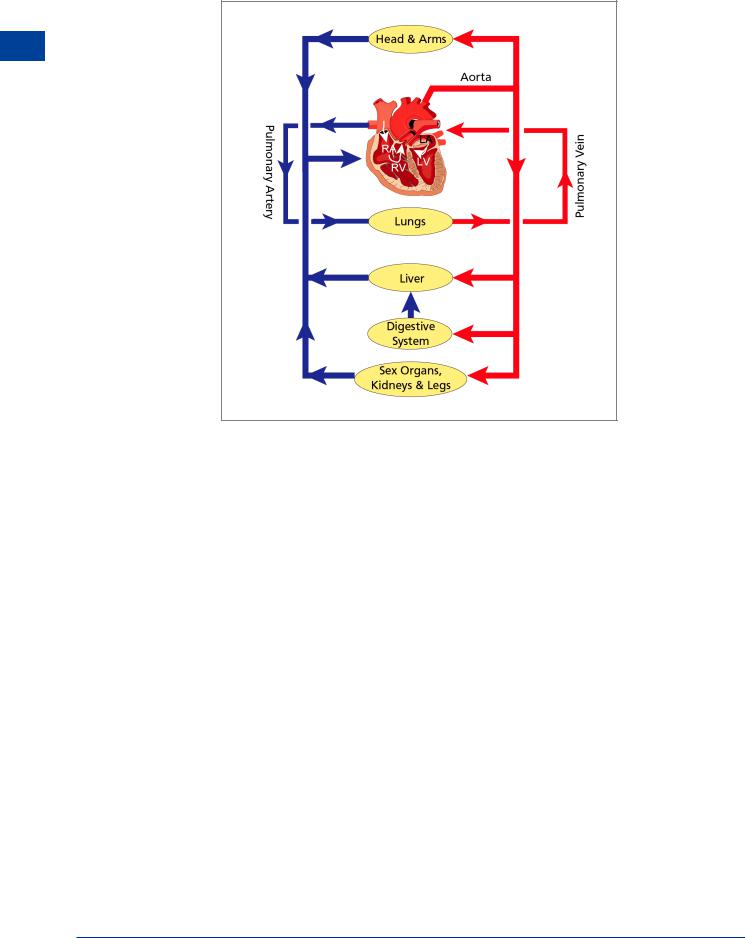
- •Textbook Series
- •Contents
- •1 Basic Concepts
- •The History of Human Performance
- •The Relevance of Human Performance in Aviation
- •ICAO Requirement for the Study of Human Factors
- •The Pilot and Pilot Training
- •Aircraft Accident Statistics
- •Flight Safety
- •The Most Significant Flight Safety Equipment
- •Safety Culture
- •Reason’s Swiss Cheese Model
- •The Five Elements of Safety Culture
- •Flight Safety/Threat and Error Management
- •Threats
- •Errors
- •Undesired Aircraft States
- •Duties of Flight Crew
- •2 The Circulation System
- •Blood Circulation
- •The Blood
- •Composition of the Blood
- •Carriage of Carbon Dioxide
- •The Circulation System
- •What Can Go Wrong
- •System Failures
- •Factors Predisposing to Heart Attack
- •Insufficient Oxygen Carried
- •Carbon Monoxide
- •Smoking
- •Blood Pressure
- •Pressoreceptors and their Function Maintaining Blood Pressure
- •Function
- •Donating Blood and Aircrew
- •Pulmonary Embolism
- •Questions
- •Answers
- •3 Oxygen and Respiration
- •Oxygen Intake
- •Thresholds of Oxygen Requirements Summary
- •Hypoxic Hypoxia
- •Hypoxic Hypoxia Symptoms
- •Stages/Zones of Hypoxia
- •Factors Determining the Severity of and the Susceptibility to Hypoxic Hypoxia
- •Anaemic Hypoxia
- •Time of Useful Consciousness (TUC)
- •Times of Useful Consciousness at Various Altitudes
- •Effective Performance Time (EPT)
- •Hyperventilation
- •Symptoms of Hyperventilation
- •Hypoxia or Hyperventilation?
- •Cabin Pressurization
- •Cabin Decompression
- •Decompression Sickness (DCS)
- •DCS in Flight and Treatment
- •Questions
- •Answers
- •4 The Nervous System, Ear, Hearing and Balance
- •Introduction
- •The Nervous System
- •The Sense Organs
- •Audible Range of the Human Ear and Measurement of Sound
- •Hearing Impairment
- •The Ear and Balance
- •Problems of Balance and Disorientation
- •Somatogyral and Somatogravic Illusions
- •Alcohol and Flying
- •Motion Sickness
- •Coping with Motion Sickness
- •Questions
- •Answers
- •5 The Eye and Vision
- •Function and Structure
- •The Cornea
- •The Iris and Pupil
- •The Lens
- •The Retina
- •The Fovea and Visual Acuity
- •Light and Dark Adaptation
- •Night Vision
- •The Blind Spot
- •Stereopsis (Stereoscopic Vision)
- •Empty Visual Field Myopia
- •High Light Levels
- •Sunglasses
- •Eye Movement
- •Visual Defects
- •Use of Contact Lenses
- •Colour Vision
- •Colour Blindness
- •Vision and Speed
- •Monocular and Binocular Vision
- •Questions
- •Answers
- •6 Flying and Health
- •Flying and Health
- •Acceleration
- •G-forces
- •Effects of Positive G-force on the Human Body
- •Long Duration Negative G
- •Short Duration G-forces
- •Susceptibility and Tolerance to G-forces
- •Summary of G Tolerances
- •Barotrauma
- •Toxic Hazards
- •Body Mass Index (BMI)
- •Obesity
- •Losing Weight
- •Exercise
- •Nutrition and Food Hygiene
- •Fits
- •Faints
- •Alcohol and Alcoholism
- •Alcohol and Flying
- •Drugs and Flying
- •Psychiatric Illnesses
- •Diseases Spread by Animals and Insects
- •Sexually Transmitted Diseases
- •Personal Hygiene
- •Stroboscopic Effect
- •Radiation
- •Common Ailments and Fitness to Fly
- •Drugs and Self-medication
- •Anaesthetics and Analgesics
- •Symptoms in the Air
- •Questions
- •Answers
- •7 Stress
- •An Introduction to Stress
- •The Stress Model
- •Arousal and Performance
- •Stress Reaction and the General Adaption Syndrome (GAS)
- •Stress Factors (Stressors)
- •Physiological Stress Factors
- •External Physiological Factors
- •Internal Physiological Factors
- •Cognitive Stress Factors/Stressors
- •Non-professional Personal Factors/Stressors
- •Stress Table
- •Imaginary Stress (Anxiety)
- •Organizational Stress
- •Stress Effects
- •Coping with Stress
- •Coping with Stress on the Flight Deck
- •Stress Management Away from the Flight Deck
- •Stress Summary
- •Questions
- •Answers
- •Introduction
- •Basic Information Processing
- •Stimuli
- •Receptors and Sensory Memories/Stores
- •Attention
- •Perception
- •Perceived Mental Models
- •Three Dimensional Models
- •Short-term Memory (Working Memory)
- •Long-term Memory
- •Central Decision Maker and Response Selection
- •Motor Programmes (Skills)
- •Human Reliability, Errors and Their Generation
- •The Learning Process
- •Mental Schema
- •Questions
- •Answers
- •9 Behaviour and Motivation
- •An Introduction to Behaviour
- •Categories of Behaviour
- •Evaluating Data
- •Situational Awareness
- •Motivation
- •Questions
- •Answers
- •10 Cognition in Aviation
- •Cognition in Aviation
- •Visual Illusions
- •An Illusion of Movement
- •Other Sources of Illusions
- •Illusions When Taxiing
- •Illusions on Take-off
- •Illusions in the Cruise
- •Approach and Landing
- •Initial Judgement of Appropriate Glideslope
- •Maintenance of the Glideslope
- •Ground Proximity Judgements
- •Protective Measures against Illusions
- •Collision and the Retinal Image
- •Human Performance Cognition in Aviation
- •Special Situations
- •Spatial Orientation in Flight and the “Seat-of-the-pants”
- •Oculogravic and Oculogyral Illusions
- •Questions
- •Answers
- •11 Sleep and Fatigue
- •General
- •Biological Rhythms and Clocks
- •Body Temperature
- •Time of Day and Performance
- •Credit/Debit Systems
- •Measurement and Phases of Sleep
- •Age and Sleep
- •Naps and Microsleeps
- •Shift Work
- •Time Zone Crossing
- •Sleep Planning
- •Sleep Hygiene
- •Sleep and Alcohol
- •Sleep Disorders
- •Drugs and Sleep Management
- •Fatigue
- •Vigilance and Hypovigilance
- •Questions
- •Answers
- •12 Individual Differences and Interpersonal Relationships
- •Introduction
- •Personality
- •Interactive Style
- •The Individual’s Contribution within a Group
- •Cohesion
- •Group Decision Making
- •Improving Group Decision Making
- •Leadership
- •The Authority Gradient and Leadership Styles
- •Interacting with Other Agencies
- •Questions
- •Answers
- •13 Communication and Cooperation
- •Introduction
- •A Simple Communications Model
- •Types of Questions
- •Communications Concepts
- •Good Communications
- •Personal Communications
- •Cockpit Communications
- •Professional Languages
- •Metacommunications
- •Briefings
- •Communications to Achieve Coordination
- •Synchronization
- •Synergy in Joint Actions
- •Barriers to Crew Cooperation and Teamwork
- •Good Team Work
- •Summary
- •Miscommunication
- •Questions
- •Answers
- •14 Man and Machine
- •Introduction
- •The Conceptual Model
- •Software
- •Hardware and Automation
- •Intelligent Flight Decks
- •Colour Displays
- •System Active and Latent Failures/Errors
- •System Tolerance
- •Design-induced Errors
- •Questions
- •Answers
- •15 Decision Making and Risk
- •Introduction
- •The Mechanics of Decision Making
- •Standard Operating Procedures
- •Errors, Sources and Limits in the Decision-making Process
- •Personality Traits and Effective Crew Decision Making
- •Judgement Concept
- •Commitment
- •Questions
- •Answers
- •16 Human Factors Incident Reporting
- •Incident Reporting
- •Aeronautical Information Circulars
- •Staines Trident Accident 1972
- •17 Introduction to Crew Resource Management
- •Introduction
- •Communication
- •Hearing Versus Listening
- •Question Types
- •Methods of Communication
- •Communication Styles
- •Overload
- •Situational Awareness and Mental Models
- •Decision Making
- •Personality
- •Where We Focus Our Attention
- •How We Acquire Information
- •How We Make Decisions
- •How People Live
- •Behaviour
- •Modes of Behaviour
- •Team Skill
- •18 Specimen Questions
- •Answers to Specimen Papers
- •Revision Questions
- •Answers to Revision Questions
- •Specimen Examination Paper
- •Answers to Specimen Examination Paper
- •Explanations to Specimen Examination Paper
- •19 Glossary
- •Glossary of Terms
- •20 Index

The Circulation System |
|
2 |
|
||
|
|
|
a large amount of oxygen is a red colour whilst blood with a shortage of oxygen is of a bluer tinge. If an artery is cut bright red blood spurts out, if a vein is cut then dark blood oozes out.
Carriage of Carbon Dioxide
A small amount of the carbon dioxide may be dissolved in the plasma but the majority is carried in chemical combination with water in the form of carbonic acid.
CO2 + H2O H2CO3
Our blood is naturally acidic because of the presence of this carbonic acid. An acidic basis is required to allow the easy release of oxygen from oxyhaemoglobin to tissues. A reduction in the acidity of the blood which can occur when there is insufficient carbon dioxide in the blood, as when hyperventilating (see Chapter 3 - Oxygen and Respiration), interferes with the release of oxygen to the tissues.
The Circulation System
The function of the circulatory system, which particularly concerns the aviator, is the carriage of oxygen to the tissues and the removal of carbon dioxide. Oxygen is required by the tissues for oxidation of food. Whereas the major source of energy for the body is carbohydrates which are a component of our food, energy can also be derived from proteins and fats. Thus those on hunger strike inevitably utilize proteins for energy.
Carbohydrates are composed only of the elements carbon, hydrogen and oxygen and in the tissues these foodstuffs combine with Oxygen to give energy:
Carbohydrates + Oxygen Energy + CO2 + H2O
This process whereby energy is released from food, takes place in the cells and is called Internal
Respiration.
Oxygen is obtained from the atmosphere and the blood picks up the oxygen from the lungs for transport around the body. Follow the path of the circulatory system as shown in Figure 2.2. The largest and most muscular part of the heart is the left ventricle. Blood containing oxygen is sent around the body from the left ventricle when it contracts. A system of one-way valves in the heart prevents blood going the wrong way.
The oxygenated blood passes through the aorta into the major arteries which divide into the smaller arteries before arriving at the smallest vessels of the system - the capillaries. The capillaries have very thin walls (only one cell thick) which allow the passage of oxygen from the blood into the tissues by diffusion (Fick’s Law). They also allow carbon dioxide and water vapour to diffuse in the reverse direction.
The Circulation System 2
21

2 |
|
The Circulation System |
|
||
|
|
|
System Circulation The 2
Figure 2.2 The circulation system
It is emphasized that this exchange can only take place at the capillaries. Even the smallest arteries and veins have walls too thick to allow the exchange of gases.
De-oxygenated blood passes from the venous capillaries to veins which progressively increase in size and returns eventually to the right atrium. It then passes to the right ventricle which pumps the blood via the pulmonary artery to the lungs. The carbon dioxide and water in the blood are released to the lungs and, at the same time, the blood is re-oxygenated. The blood then returns to the heart via the pulmonary vein and left auricle. It is then pumped back into the aorta by the left ventricle.
Cardiac Output
Cardiac output is the quantity of blood pumped by the left ventricle into the aorta each minute. It is the product of the stroke volume and the heart rate (or pulse rate). The normal pulse rate for a healthy average individual is 70 beats a minute. The stroke volume of a healthy heart remains constant and thus cardiac output will increase linearly with an increase in pulse rate. The limit of effective heart rate in man is about 180 beats a minutes. Above this, the heart cannot fill up quickly enough and cardiac output will decrease.
The cardiac output for the average human being at rest is 5.0 to 5.5 litres a minute.
22

The Circulation System |
|
2 |
|
||
|
|
|
Factors Determining Pulse Rate
The pulse rate will increase or decrease resulting from a number of factors as the demand for oxygen varies. Among the principal factors are:
•Exercise.
•Altitude.
•Temperature.
The pulse rate can also vary as a result of the sympathetic/parasympathetic control of the heart. This is discussed in Chapter 6. Among these factors are:
•Fight or Flight (GAS) Syndrome.
•Shock.
•Emotion (fear, anxiety and anger).
What Can Go Wrong
The efficient distribution of oxygen may be disturbed in two ways:
•The system (heart, arteries, veins etc.) can develop a fault.
•The blood is unable to carry enough oxygen for the needs of the tissue cells.
System Failures
The heart (pump) can be damaged. Heart tissue is muscle which responds to electrical impulses from the brain to contract or relax systematically. Sometimes this controlling system does not carry the impulses in a coordinated way. The heart beat may become irregular or even fail altogether.
In modern surgery a mechanical device (pacemaker) may be implanted to produce the regular electrical impulses to cause the heart to beat at a regular rate. These electrical impulses and their synchronisation with the heart’s pulse rate can be measured, by an electrocardiogram (ECG). An ECG test is incorporated in aircrew medical examinations.
The heart muscles require oxygen to continue working. This oxygen is carried to the heart by the coronary arteries. If a narrowing of these vessels should occur then insufficient blood may reach the heart muscle. This lack of oxygen, particularly when the heart is beating faster due to exercise or stress, will give rise to the symptoms of angina, with pain in the chest and sometimes the arms.
If the blood supply is cut off completely then a portion of the heart muscle may die (an infarct). The dead tissue is unable to carry the electrical impulses and the heart beat may become irregular or even fail completely (a heart attack).
Heart Attack (Myocardial Infarction).
Angina is often a precursor to the development of a heart attack. Approximately half of those who have a myocardial infarction die immediately. A proportion go on to develop an associated abnormality of the heart rhythm which can completely interrupt the co-ordinated muscular contractions of the heart (cardiac arrest).
The most common of these disturbances is called ventricular fibrillation. If this can be treated promptly with an application of DC shock via a Defibrillator, then the heart may revert to
The Circulation System 2
23

2 |
|
The Circulation System |
|
||
|
|
|
System Circulation The 2
its normal rhythm and the patient may survive. If the patient’s essential circulation can be supported by cardiac massage and assisted ventilation, he/she may survive while waiting for a defibrillator to be available. Without treatment cardiac arrest is fatal within 4 minutes.
Those who survive the first 24 hours post myocardial infarction will have a good chance of recovery however the retrieval of a flying licence will not be possible without extensive investigation and - in any case - a restriction to multi-crew operations will always be imposed.
Factors Predisposing to Heart Attack
The factors predisposing to a heart attack, in order of importance, are:
•Family History (heredity).
•Age.
•Previous history of cardiovascular problems.
•Raised blood pressure (hypertension).
•Smoking.
•Raised blood cholesterol.
•Lack of exercise.
•Diabetes.
Other factors such as stress, obesity, alcohol and certain dietary considerations are less clearly understood. It is noteworthy that coronary disease is responsible for 70% of pilot deaths during their careers.
Incapacitation in Flight
The dramatic and sudden incapacitation of a pilot during flight is uncommon and very rarely the cause of an accident. An aircraft accident at Staines was one of the very few major accidents in civil aviation due to the pilot suffering a heart attack. Rigorous medical selection and periodic health checks minimize the risk of total incapacitation due to heart disease, epilepsy etc. As the pilot grows older the frequency of medical checks increases. ECG (electrocardiogram) and EEG (electroencephalogram) recordings are used more and more to spot those at risk.
Insufficient Oxygen Carried
The cells of the various tissues may be deprived of the oxygen they need because of:
•Insufficient haemoglobin or red blood cells (anaemia). This can be primarily caused by the breakdown of the production process of haemoglobin in the bone marrow or by excessive bleeding.
•Insufficient pressure of oxygen in the air. The pressure of oxygen in the air (partial pressure) reduces with altitude and people who live at high altitude for a prolonged period produce more red blood cells than those who live at sea level. In other cases it will be necessary to add oxygen to the air breathed. This topic is treated fully in the next chapter.
•A lack of iron.
24
